Procurement A2: Evaluation, Supplier Selection and Contract Management
VerifiedAdded on 2022/10/09
|18
|3485
|52
Report
AI Summary
This report presents a comprehensive evaluation plan designed to guide the selection of a Facility Management Company (FMC) for an Australian organization, starting in 2020. The FMC will be responsible for maintaining building fabrics, electrical, hydraulics, and mechanical equipment, along with the upkeep of external areas. The report details the creation of a Request for Proposal (RFQ), contract awarding, and specifies contract information such as quotation guidelines, selection criteria, and communication methods with unsuccessful bidders. The evaluation process aims to secure the best value for money, ensure a transparent tender process, and optimize business productivity. The background includes the organization's spending on maintenance, probity, and accountability measures to ensure fairness, and a procurement methodology. The report outlines the evaluation schedule, tender evaluation process, compliance and selection criteria, and contract management aspects including contract summary, key contacts, responsibilities, contract delivery requirements, KPIs, performance management, risk assessment, communication, contract variations, and termination. This plan provides a detailed framework for selecting and managing an FMC, ensuring efficient building maintenance and refurbishment projects.
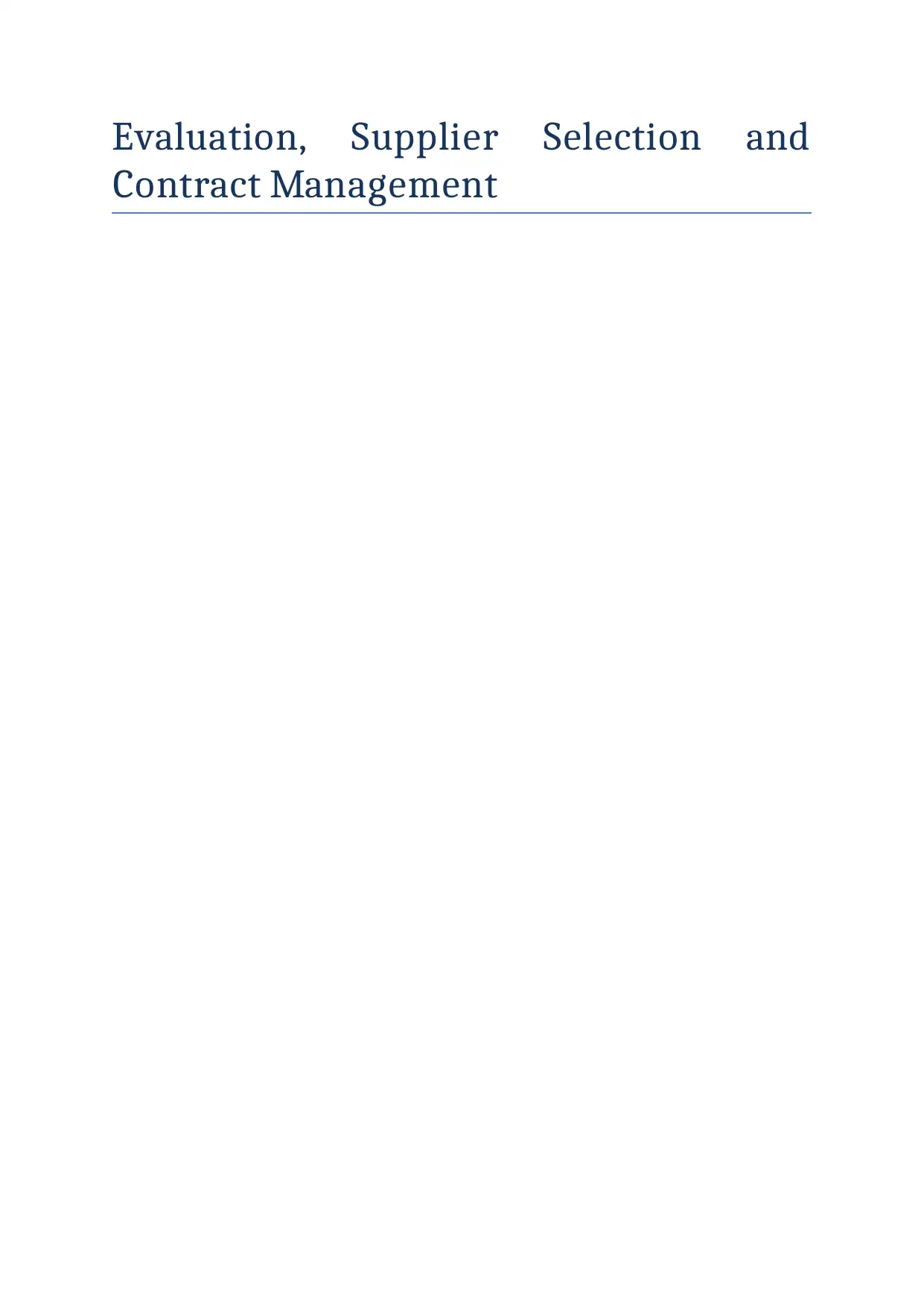
Evaluation, Supplier Selection and
Contract Management
Contract Management
Paraphrase This Document
Need a fresh take? Get an instant paraphrase of this document with our AI Paraphraser
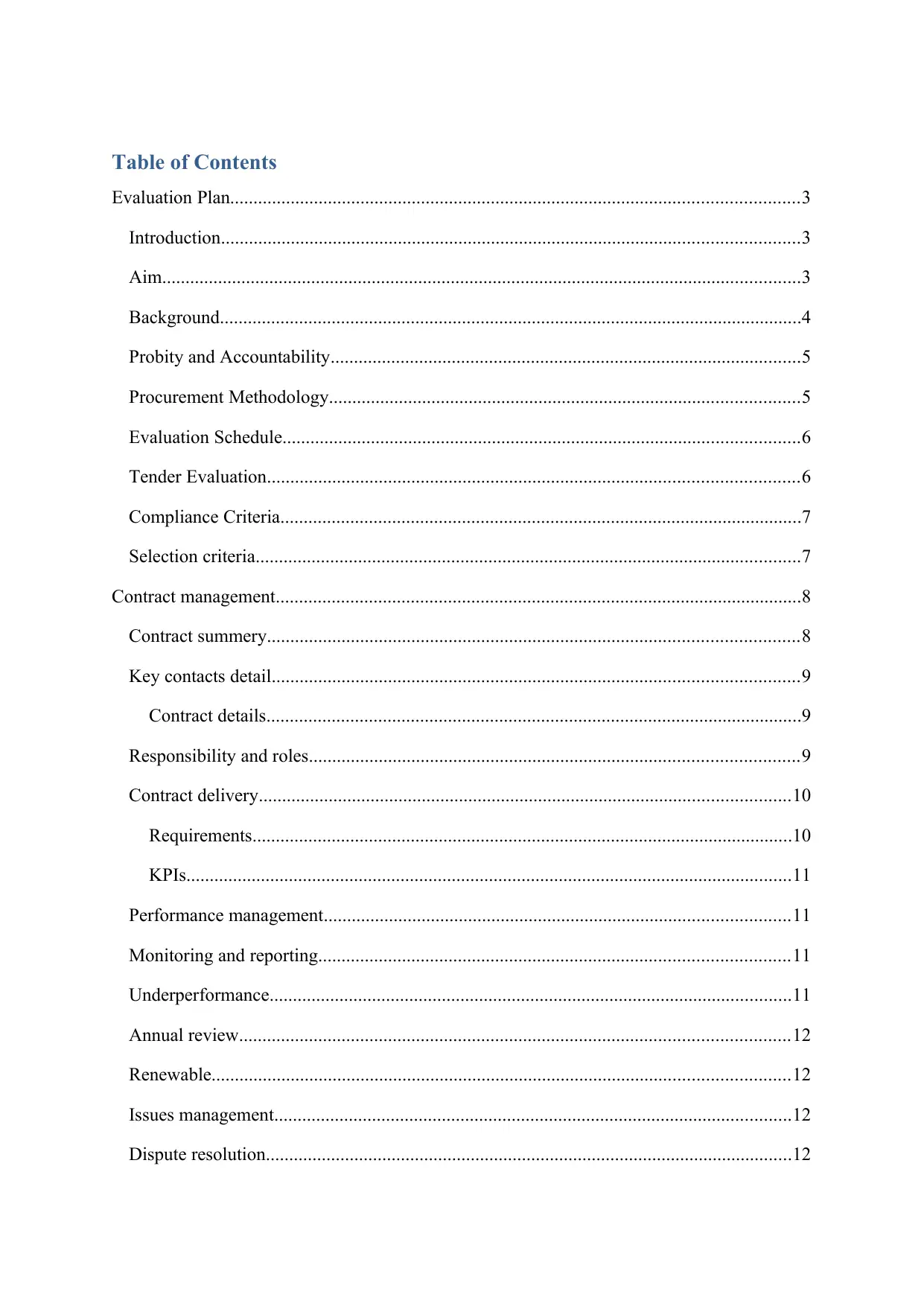
Table of Contents
Evaluation Plan..........................................................................................................................3
Introduction............................................................................................................................3
Aim.........................................................................................................................................3
Background.............................................................................................................................4
Probity and Accountability.....................................................................................................5
Procurement Methodology.....................................................................................................5
Evaluation Schedule...............................................................................................................6
Tender Evaluation..................................................................................................................6
Compliance Criteria................................................................................................................7
Selection criteria.....................................................................................................................7
Contract management.................................................................................................................8
Contract summery..................................................................................................................8
Key contacts detail.................................................................................................................9
Contract details...................................................................................................................9
Responsibility and roles.........................................................................................................9
Contract delivery..................................................................................................................10
Requirements....................................................................................................................10
KPIs..................................................................................................................................11
Performance management....................................................................................................11
Monitoring and reporting.....................................................................................................11
Underperformance................................................................................................................11
Annual review......................................................................................................................12
Renewable............................................................................................................................12
Issues management...............................................................................................................12
Dispute resolution.................................................................................................................12
Evaluation Plan..........................................................................................................................3
Introduction............................................................................................................................3
Aim.........................................................................................................................................3
Background.............................................................................................................................4
Probity and Accountability.....................................................................................................5
Procurement Methodology.....................................................................................................5
Evaluation Schedule...............................................................................................................6
Tender Evaluation..................................................................................................................6
Compliance Criteria................................................................................................................7
Selection criteria.....................................................................................................................7
Contract management.................................................................................................................8
Contract summery..................................................................................................................8
Key contacts detail.................................................................................................................9
Contract details...................................................................................................................9
Responsibility and roles.........................................................................................................9
Contract delivery..................................................................................................................10
Requirements....................................................................................................................10
KPIs..................................................................................................................................11
Performance management....................................................................................................11
Monitoring and reporting.....................................................................................................11
Underperformance................................................................................................................11
Annual review......................................................................................................................12
Renewable............................................................................................................................12
Issues management...............................................................................................................12
Dispute resolution.................................................................................................................12
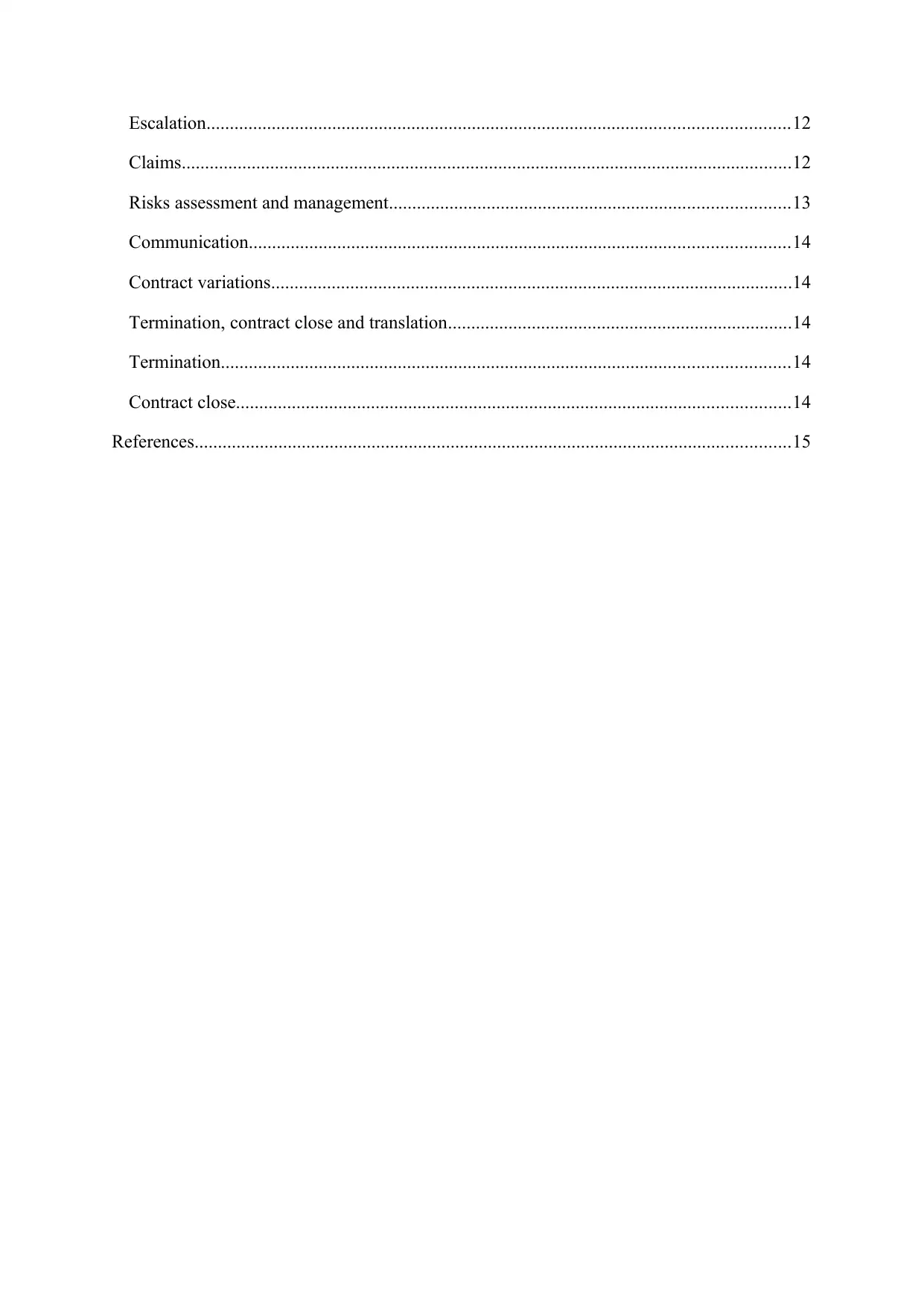
Escalation.............................................................................................................................12
Claims...................................................................................................................................12
Risks assessment and management......................................................................................13
Communication....................................................................................................................14
Contract variations................................................................................................................14
Termination, contract close and translation..........................................................................14
Termination..........................................................................................................................14
Contract close.......................................................................................................................14
References................................................................................................................................15
Claims...................................................................................................................................12
Risks assessment and management......................................................................................13
Communication....................................................................................................................14
Contract variations................................................................................................................14
Termination, contract close and translation..........................................................................14
Termination..........................................................................................................................14
Contract close.......................................................................................................................14
References................................................................................................................................15
⊘ This is a preview!⊘
Do you want full access?
Subscribe today to unlock all pages.

Trusted by 1+ million students worldwide
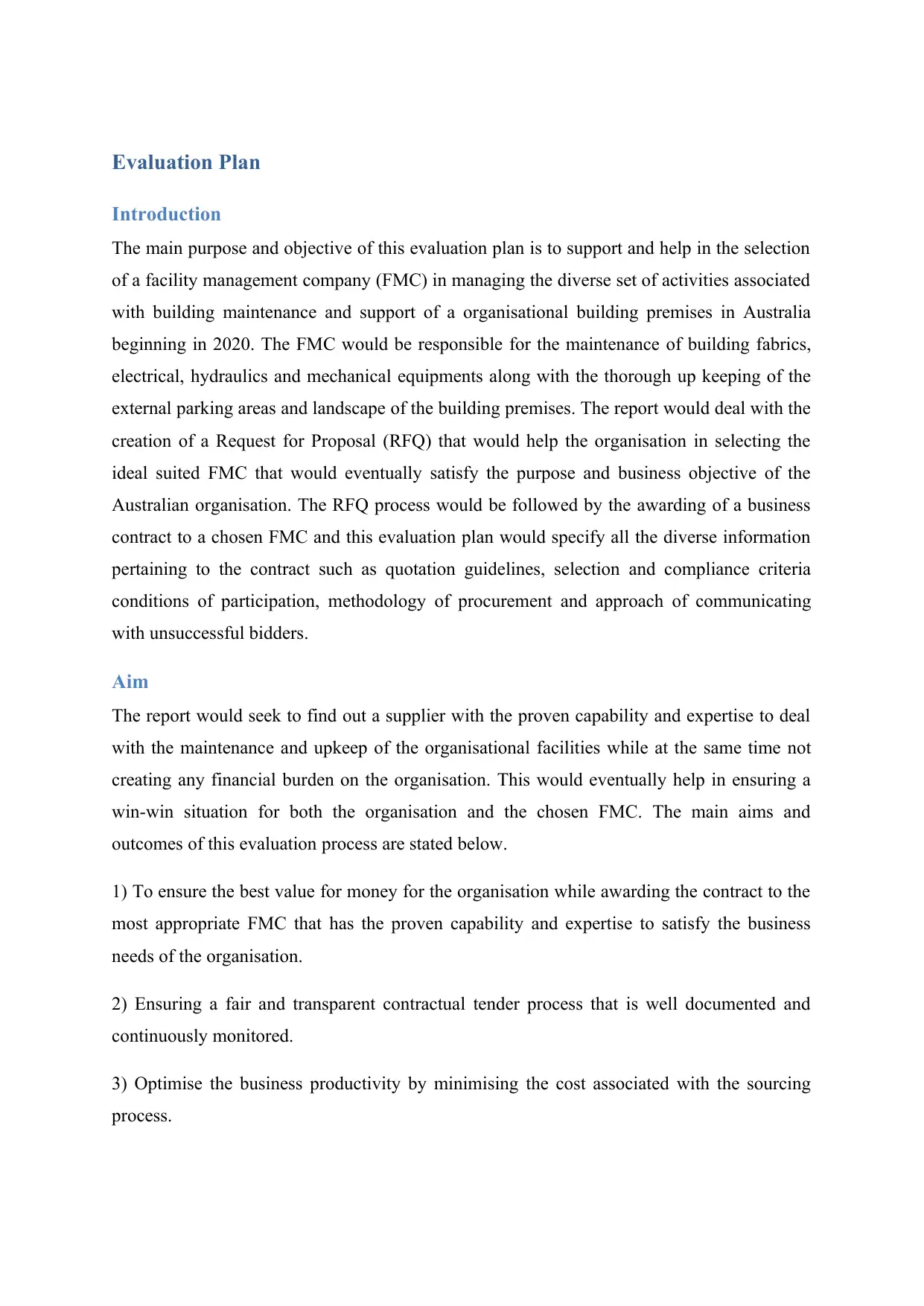
Evaluation Plan
Introduction
The main purpose and objective of this evaluation plan is to support and help in the selection
of a facility management company (FMC) in managing the diverse set of activities associated
with building maintenance and support of a organisational building premises in Australia
beginning in 2020. The FMC would be responsible for the maintenance of building fabrics,
electrical, hydraulics and mechanical equipments along with the thorough up keeping of the
external parking areas and landscape of the building premises. The report would deal with the
creation of a Request for Proposal (RFQ) that would help the organisation in selecting the
ideal suited FMC that would eventually satisfy the purpose and business objective of the
Australian organisation. The RFQ process would be followed by the awarding of a business
contract to a chosen FMC and this evaluation plan would specify all the diverse information
pertaining to the contract such as quotation guidelines, selection and compliance criteria
conditions of participation, methodology of procurement and approach of communicating
with unsuccessful bidders.
Aim
The report would seek to find out a supplier with the proven capability and expertise to deal
with the maintenance and upkeep of the organisational facilities while at the same time not
creating any financial burden on the organisation. This would eventually help in ensuring a
win-win situation for both the organisation and the chosen FMC. The main aims and
outcomes of this evaluation process are stated below.
1) To ensure the best value for money for the organisation while awarding the contract to the
most appropriate FMC that has the proven capability and expertise to satisfy the business
needs of the organisation.
2) Ensuring a fair and transparent contractual tender process that is well documented and
continuously monitored.
3) Optimise the business productivity by minimising the cost associated with the sourcing
process.
Introduction
The main purpose and objective of this evaluation plan is to support and help in the selection
of a facility management company (FMC) in managing the diverse set of activities associated
with building maintenance and support of a organisational building premises in Australia
beginning in 2020. The FMC would be responsible for the maintenance of building fabrics,
electrical, hydraulics and mechanical equipments along with the thorough up keeping of the
external parking areas and landscape of the building premises. The report would deal with the
creation of a Request for Proposal (RFQ) that would help the organisation in selecting the
ideal suited FMC that would eventually satisfy the purpose and business objective of the
Australian organisation. The RFQ process would be followed by the awarding of a business
contract to a chosen FMC and this evaluation plan would specify all the diverse information
pertaining to the contract such as quotation guidelines, selection and compliance criteria
conditions of participation, methodology of procurement and approach of communicating
with unsuccessful bidders.
Aim
The report would seek to find out a supplier with the proven capability and expertise to deal
with the maintenance and upkeep of the organisational facilities while at the same time not
creating any financial burden on the organisation. This would eventually help in ensuring a
win-win situation for both the organisation and the chosen FMC. The main aims and
outcomes of this evaluation process are stated below.
1) To ensure the best value for money for the organisation while awarding the contract to the
most appropriate FMC that has the proven capability and expertise to satisfy the business
needs of the organisation.
2) Ensuring a fair and transparent contractual tender process that is well documented and
continuously monitored.
3) Optimise the business productivity by minimising the cost associated with the sourcing
process.
Paraphrase This Document
Need a fresh take? Get an instant paraphrase of this document with our AI Paraphraser
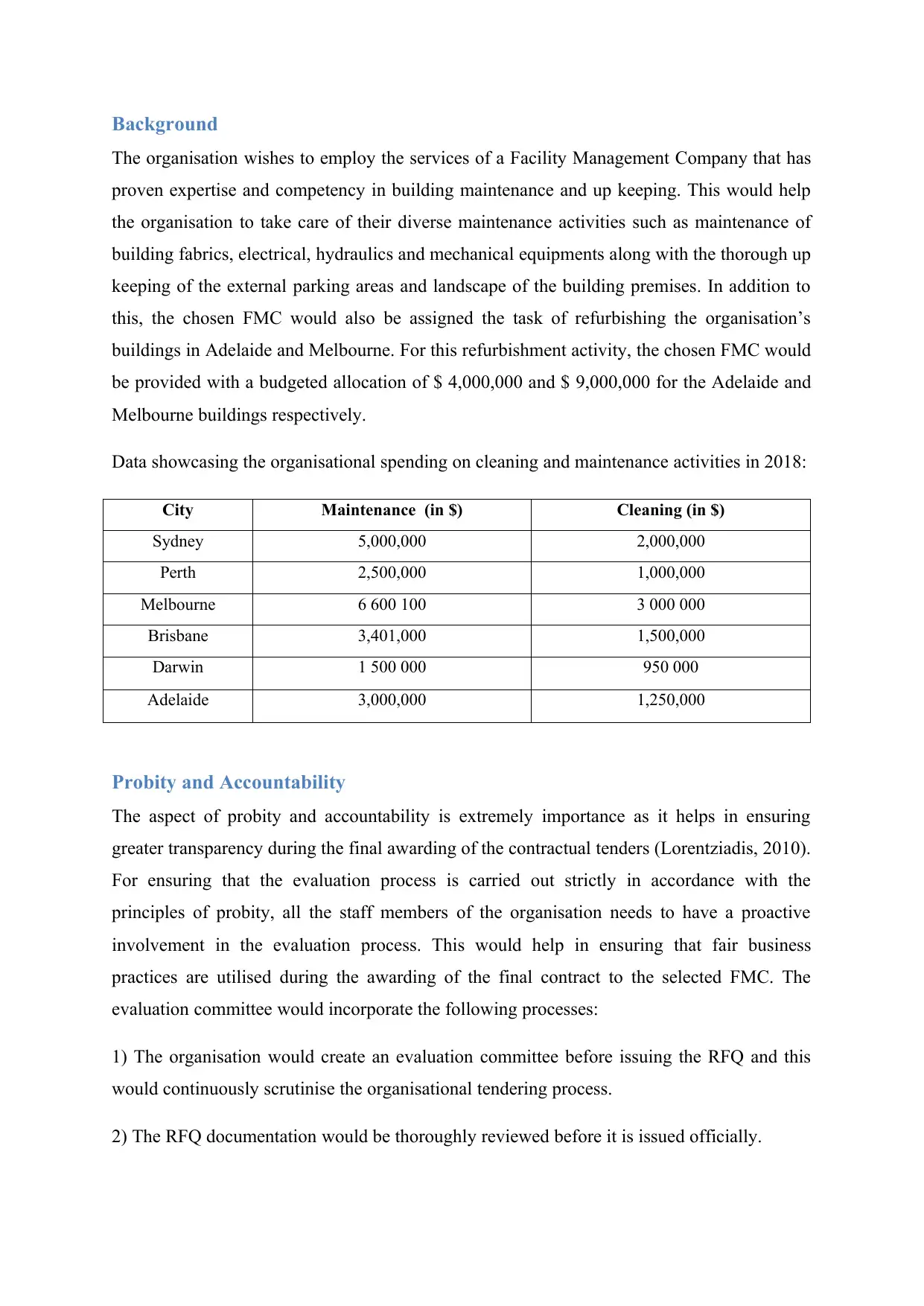
Background
The organisation wishes to employ the services of a Facility Management Company that has
proven expertise and competency in building maintenance and up keeping. This would help
the organisation to take care of their diverse maintenance activities such as maintenance of
building fabrics, electrical, hydraulics and mechanical equipments along with the thorough up
keeping of the external parking areas and landscape of the building premises. In addition to
this, the chosen FMC would also be assigned the task of refurbishing the organisation’s
buildings in Adelaide and Melbourne. For this refurbishment activity, the chosen FMC would
be provided with a budgeted allocation of $ 4,000,000 and $ 9,000,000 for the Adelaide and
Melbourne buildings respectively.
Data showcasing the organisational spending on cleaning and maintenance activities in 2018:
City Maintenance (in $) Cleaning (in $)
Sydney 5,000,000 2,000,000
Perth 2,500,000 1,000,000
Melbourne 6 600 100 3 000 000
Brisbane 3,401,000 1,500,000
Darwin 1 500 000 950 000
Adelaide 3,000,000 1,250,000
Probity and Accountability
The aspect of probity and accountability is extremely importance as it helps in ensuring
greater transparency during the final awarding of the contractual tenders (Lorentziadis, 2010).
For ensuring that the evaluation process is carried out strictly in accordance with the
principles of probity, all the staff members of the organisation needs to have a proactive
involvement in the evaluation process. This would help in ensuring that fair business
practices are utilised during the awarding of the final contract to the selected FMC. The
evaluation committee would incorporate the following processes:
1) The organisation would create an evaluation committee before issuing the RFQ and this
would continuously scrutinise the organisational tendering process.
2) The RFQ documentation would be thoroughly reviewed before it is issued officially.
The organisation wishes to employ the services of a Facility Management Company that has
proven expertise and competency in building maintenance and up keeping. This would help
the organisation to take care of their diverse maintenance activities such as maintenance of
building fabrics, electrical, hydraulics and mechanical equipments along with the thorough up
keeping of the external parking areas and landscape of the building premises. In addition to
this, the chosen FMC would also be assigned the task of refurbishing the organisation’s
buildings in Adelaide and Melbourne. For this refurbishment activity, the chosen FMC would
be provided with a budgeted allocation of $ 4,000,000 and $ 9,000,000 for the Adelaide and
Melbourne buildings respectively.
Data showcasing the organisational spending on cleaning and maintenance activities in 2018:
City Maintenance (in $) Cleaning (in $)
Sydney 5,000,000 2,000,000
Perth 2,500,000 1,000,000
Melbourne 6 600 100 3 000 000
Brisbane 3,401,000 1,500,000
Darwin 1 500 000 950 000
Adelaide 3,000,000 1,250,000
Probity and Accountability
The aspect of probity and accountability is extremely importance as it helps in ensuring
greater transparency during the final awarding of the contractual tenders (Lorentziadis, 2010).
For ensuring that the evaluation process is carried out strictly in accordance with the
principles of probity, all the staff members of the organisation needs to have a proactive
involvement in the evaluation process. This would help in ensuring that fair business
practices are utilised during the awarding of the final contract to the selected FMC. The
evaluation committee would incorporate the following processes:
1) The organisation would create an evaluation committee before issuing the RFQ and this
would continuously scrutinise the organisational tendering process.
2) The RFQ documentation would be thoroughly reviewed before it is issued officially.
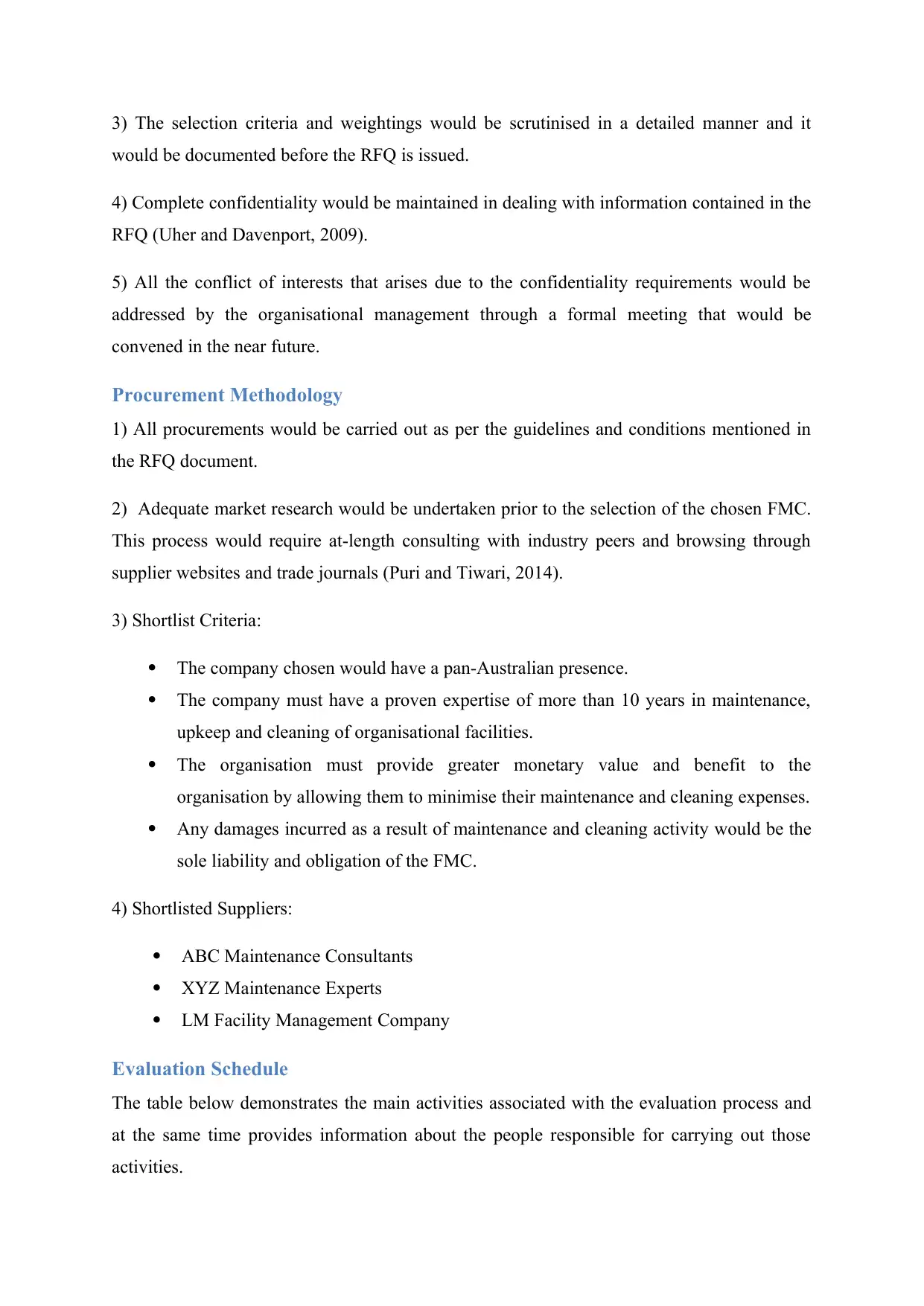
3) The selection criteria and weightings would be scrutinised in a detailed manner and it
would be documented before the RFQ is issued.
4) Complete confidentiality would be maintained in dealing with information contained in the
RFQ (Uher and Davenport, 2009).
5) All the conflict of interests that arises due to the confidentiality requirements would be
addressed by the organisational management through a formal meeting that would be
convened in the near future.
Procurement Methodology
1) All procurements would be carried out as per the guidelines and conditions mentioned in
the RFQ document.
2) Adequate market research would be undertaken prior to the selection of the chosen FMC.
This process would require at-length consulting with industry peers and browsing through
supplier websites and trade journals (Puri and Tiwari, 2014).
3) Shortlist Criteria:
The company chosen would have a pan-Australian presence.
The company must have a proven expertise of more than 10 years in maintenance,
upkeep and cleaning of organisational facilities.
The organisation must provide greater monetary value and benefit to the
organisation by allowing them to minimise their maintenance and cleaning expenses.
Any damages incurred as a result of maintenance and cleaning activity would be the
sole liability and obligation of the FMC.
4) Shortlisted Suppliers:
ABC Maintenance Consultants
XYZ Maintenance Experts
LM Facility Management Company
Evaluation Schedule
The table below demonstrates the main activities associated with the evaluation process and
at the same time provides information about the people responsible for carrying out those
activities.
would be documented before the RFQ is issued.
4) Complete confidentiality would be maintained in dealing with information contained in the
RFQ (Uher and Davenport, 2009).
5) All the conflict of interests that arises due to the confidentiality requirements would be
addressed by the organisational management through a formal meeting that would be
convened in the near future.
Procurement Methodology
1) All procurements would be carried out as per the guidelines and conditions mentioned in
the RFQ document.
2) Adequate market research would be undertaken prior to the selection of the chosen FMC.
This process would require at-length consulting with industry peers and browsing through
supplier websites and trade journals (Puri and Tiwari, 2014).
3) Shortlist Criteria:
The company chosen would have a pan-Australian presence.
The company must have a proven expertise of more than 10 years in maintenance,
upkeep and cleaning of organisational facilities.
The organisation must provide greater monetary value and benefit to the
organisation by allowing them to minimise their maintenance and cleaning expenses.
Any damages incurred as a result of maintenance and cleaning activity would be the
sole liability and obligation of the FMC.
4) Shortlisted Suppliers:
ABC Maintenance Consultants
XYZ Maintenance Experts
LM Facility Management Company
Evaluation Schedule
The table below demonstrates the main activities associated with the evaluation process and
at the same time provides information about the people responsible for carrying out those
activities.
⊘ This is a preview!⊘
Do you want full access?
Subscribe today to unlock all pages.

Trusted by 1+ million students worldwide
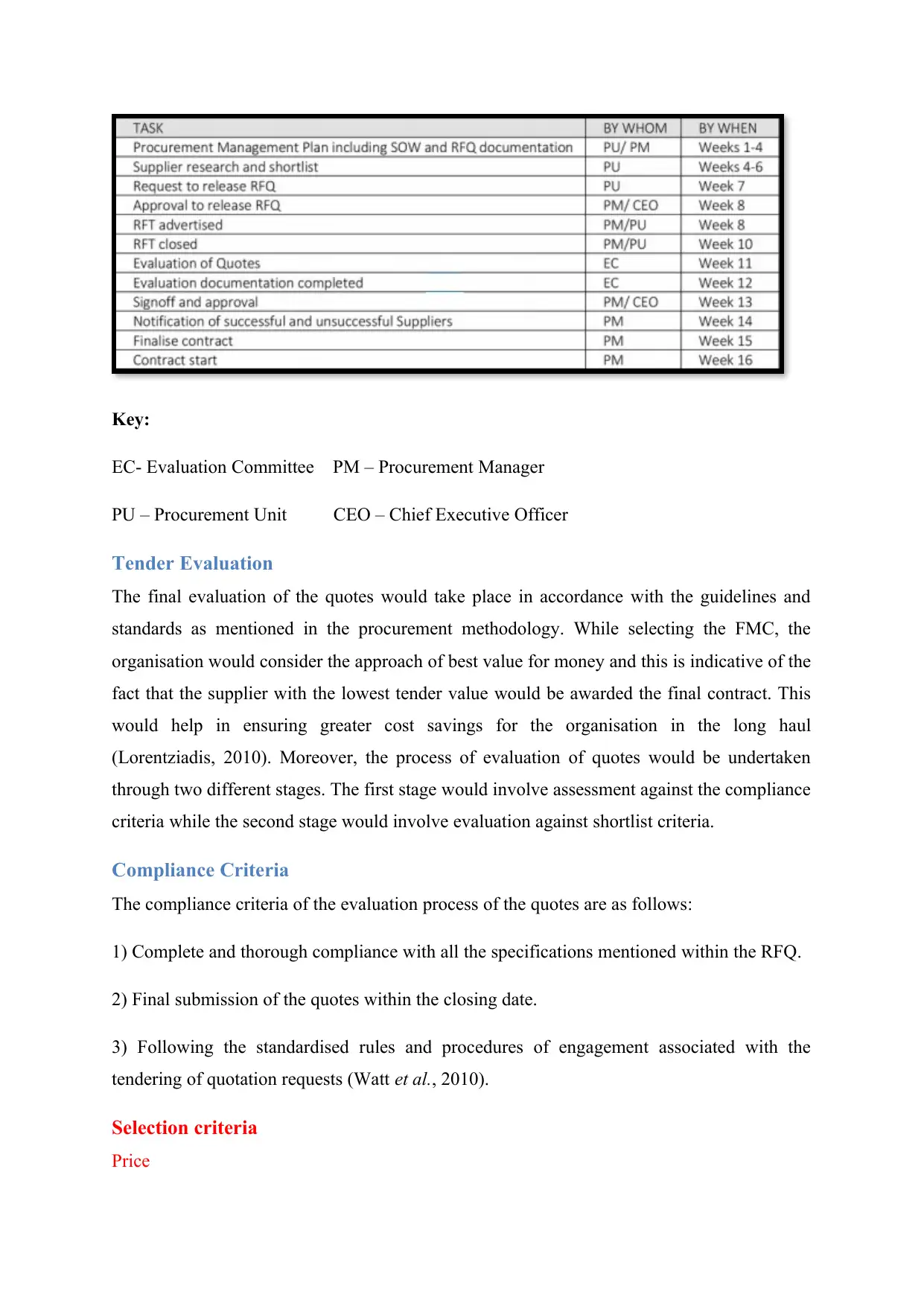
Key:
EC- Evaluation Committee PM – Procurement Manager
PU – Procurement Unit CEO – Chief Executive Officer
Tender Evaluation
The final evaluation of the quotes would take place in accordance with the guidelines and
standards as mentioned in the procurement methodology. While selecting the FMC, the
organisation would consider the approach of best value for money and this is indicative of the
fact that the supplier with the lowest tender value would be awarded the final contract. This
would help in ensuring greater cost savings for the organisation in the long haul
(Lorentziadis, 2010). Moreover, the process of evaluation of quotes would be undertaken
through two different stages. The first stage would involve assessment against the compliance
criteria while the second stage would involve evaluation against shortlist criteria.
Compliance Criteria
The compliance criteria of the evaluation process of the quotes are as follows:
1) Complete and thorough compliance with all the specifications mentioned within the RFQ.
2) Final submission of the quotes within the closing date.
3) Following the standardised rules and procedures of engagement associated with the
tendering of quotation requests (Watt et al., 2010).
Selection criteria
Price
EC- Evaluation Committee PM – Procurement Manager
PU – Procurement Unit CEO – Chief Executive Officer
Tender Evaluation
The final evaluation of the quotes would take place in accordance with the guidelines and
standards as mentioned in the procurement methodology. While selecting the FMC, the
organisation would consider the approach of best value for money and this is indicative of the
fact that the supplier with the lowest tender value would be awarded the final contract. This
would help in ensuring greater cost savings for the organisation in the long haul
(Lorentziadis, 2010). Moreover, the process of evaluation of quotes would be undertaken
through two different stages. The first stage would involve assessment against the compliance
criteria while the second stage would involve evaluation against shortlist criteria.
Compliance Criteria
The compliance criteria of the evaluation process of the quotes are as follows:
1) Complete and thorough compliance with all the specifications mentioned within the RFQ.
2) Final submission of the quotes within the closing date.
3) Following the standardised rules and procedures of engagement associated with the
tendering of quotation requests (Watt et al., 2010).
Selection criteria
Price
Paraphrase This Document
Need a fresh take? Get an instant paraphrase of this document with our AI Paraphraser
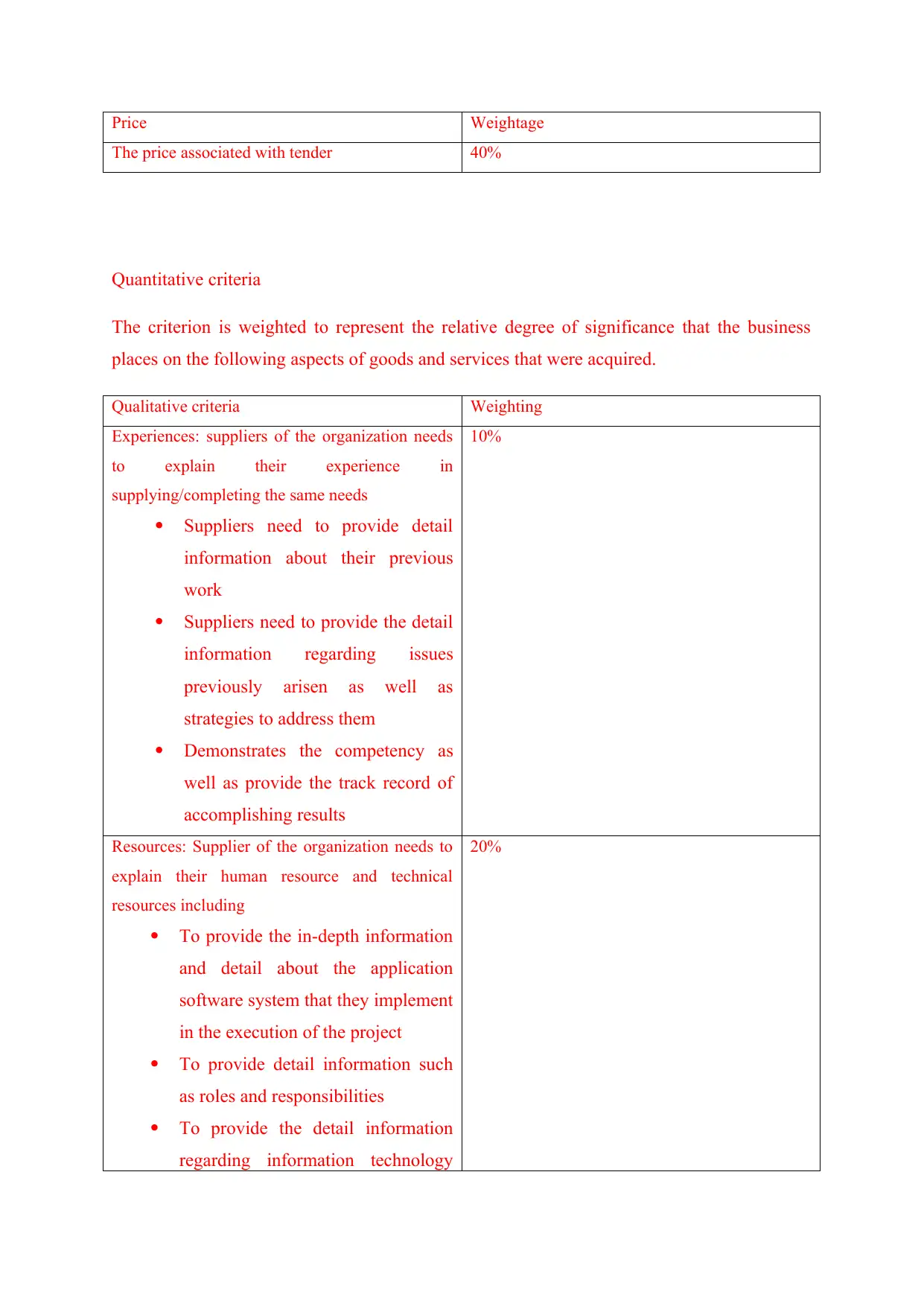
Price Weightage
The price associated with tender 40%
Quantitative criteria
The criterion is weighted to represent the relative degree of significance that the business
places on the following aspects of goods and services that were acquired.
Qualitative criteria Weighting
Experiences: suppliers of the organization needs
to explain their experience in
supplying/completing the same needs
Suppliers need to provide detail
information about their previous
work
Suppliers need to provide the detail
information regarding issues
previously arisen as well as
strategies to address them
Demonstrates the competency as
well as provide the track record of
accomplishing results
10%
Resources: Supplier of the organization needs to
explain their human resource and technical
resources including
To provide the in-depth information
and detail about the application
software system that they implement
in the execution of the project
To provide detail information such
as roles and responsibilities
To provide the detail information
regarding information technology
20%
The price associated with tender 40%
Quantitative criteria
The criterion is weighted to represent the relative degree of significance that the business
places on the following aspects of goods and services that were acquired.
Qualitative criteria Weighting
Experiences: suppliers of the organization needs
to explain their experience in
supplying/completing the same needs
Suppliers need to provide detail
information about their previous
work
Suppliers need to provide the detail
information regarding issues
previously arisen as well as
strategies to address them
Demonstrates the competency as
well as provide the track record of
accomplishing results
10%
Resources: Supplier of the organization needs to
explain their human resource and technical
resources including
To provide the in-depth information
and detail about the application
software system that they implement
in the execution of the project
To provide detail information such
as roles and responsibilities
To provide the detail information
regarding information technology
20%
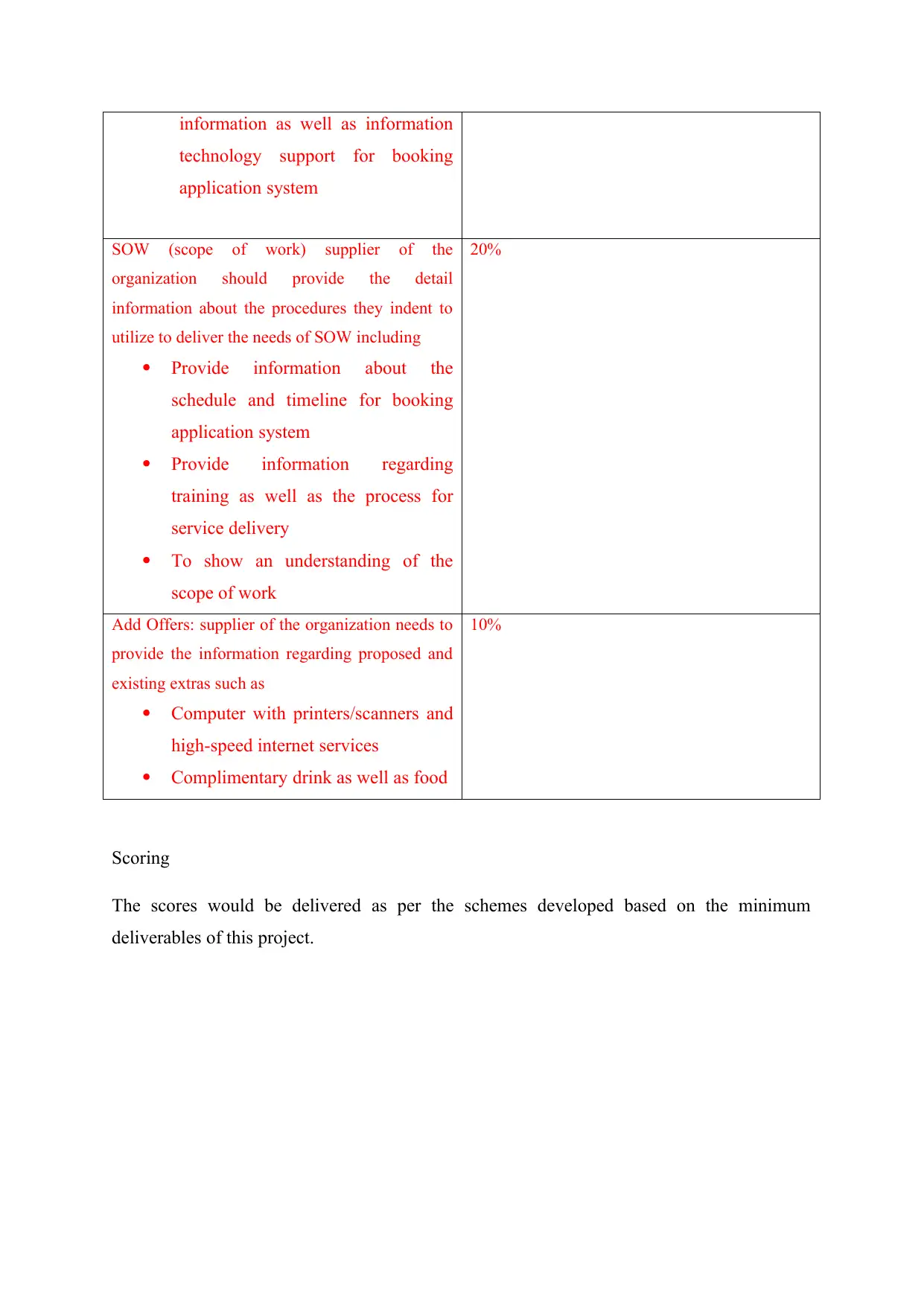
information as well as information
technology support for booking
application system
SOW (scope of work) supplier of the
organization should provide the detail
information about the procedures they indent to
utilize to deliver the needs of SOW including
Provide information about the
schedule and timeline for booking
application system
Provide information regarding
training as well as the process for
service delivery
To show an understanding of the
scope of work
20%
Add Offers: supplier of the organization needs to
provide the information regarding proposed and
existing extras such as
Computer with printers/scanners and
high-speed internet services
Complimentary drink as well as food
10%
Scoring
The scores would be delivered as per the schemes developed based on the minimum
deliverables of this project.
technology support for booking
application system
SOW (scope of work) supplier of the
organization should provide the detail
information about the procedures they indent to
utilize to deliver the needs of SOW including
Provide information about the
schedule and timeline for booking
application system
Provide information regarding
training as well as the process for
service delivery
To show an understanding of the
scope of work
20%
Add Offers: supplier of the organization needs to
provide the information regarding proposed and
existing extras such as
Computer with printers/scanners and
high-speed internet services
Complimentary drink as well as food
10%
Scoring
The scores would be delivered as per the schemes developed based on the minimum
deliverables of this project.
⊘ This is a preview!⊘
Do you want full access?
Subscribe today to unlock all pages.

Trusted by 1+ million students worldwide
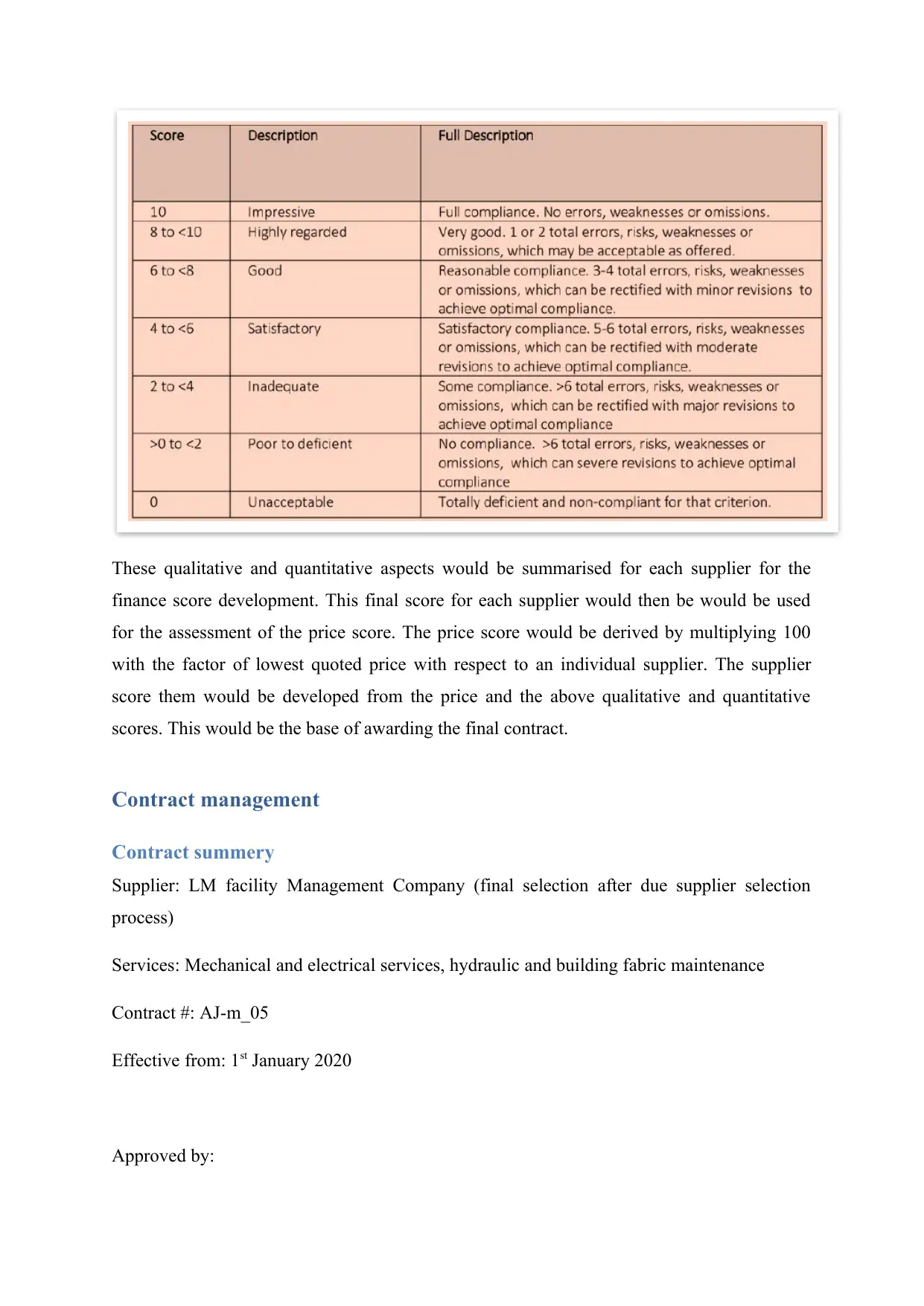
These qualitative and quantitative aspects would be summarised for each supplier for the
finance score development. This final score for each supplier would then be would be used
for the assessment of the price score. The price score would be derived by multiplying 100
with the factor of lowest quoted price with respect to an individual supplier. The supplier
score them would be developed from the price and the above qualitative and quantitative
scores. This would be the base of awarding the final contract.
Contract management
Contract summery
Supplier: LM facility Management Company (final selection after due supplier selection
process)
Services: Mechanical and electrical services, hydraulic and building fabric maintenance
Contract #: AJ-m_05
Effective from: 1st January 2020
Approved by:
finance score development. This final score for each supplier would then be would be used
for the assessment of the price score. The price score would be derived by multiplying 100
with the factor of lowest quoted price with respect to an individual supplier. The supplier
score them would be developed from the price and the above qualitative and quantitative
scores. This would be the base of awarding the final contract.
Contract management
Contract summery
Supplier: LM facility Management Company (final selection after due supplier selection
process)
Services: Mechanical and electrical services, hydraulic and building fabric maintenance
Contract #: AJ-m_05
Effective from: 1st January 2020
Approved by:
Paraphrase This Document
Need a fresh take? Get an instant paraphrase of this document with our AI Paraphraser
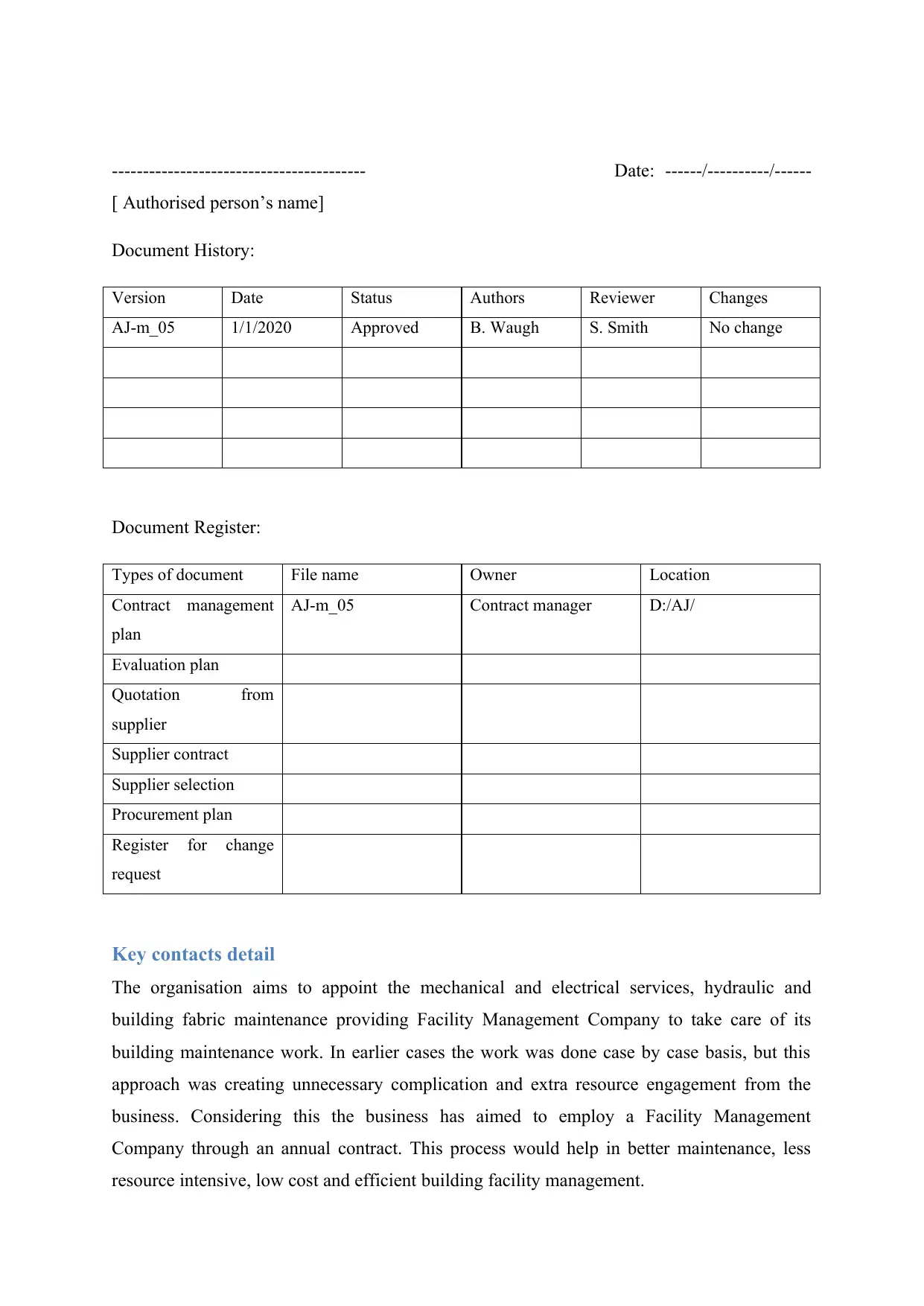
----------------------------------------- Date: ------/----------/------
[ Authorised person’s name]
Document History:
Version Date Status Authors Reviewer Changes
AJ-m_05 1/1/2020 Approved B. Waugh S. Smith No change
Document Register:
Types of document File name Owner Location
Contract management
plan
AJ-m_05 Contract manager D:/AJ/
Evaluation plan
Quotation from
supplier
Supplier contract
Supplier selection
Procurement plan
Register for change
request
Key contacts detail
The organisation aims to appoint the mechanical and electrical services, hydraulic and
building fabric maintenance providing Facility Management Company to take care of its
building maintenance work. In earlier cases the work was done case by case basis, but this
approach was creating unnecessary complication and extra resource engagement from the
business. Considering this the business has aimed to employ a Facility Management
Company through an annual contract. This process would help in better maintenance, less
resource intensive, low cost and efficient building facility management.
[ Authorised person’s name]
Document History:
Version Date Status Authors Reviewer Changes
AJ-m_05 1/1/2020 Approved B. Waugh S. Smith No change
Document Register:
Types of document File name Owner Location
Contract management
plan
AJ-m_05 Contract manager D:/AJ/
Evaluation plan
Quotation from
supplier
Supplier contract
Supplier selection
Procurement plan
Register for change
request
Key contacts detail
The organisation aims to appoint the mechanical and electrical services, hydraulic and
building fabric maintenance providing Facility Management Company to take care of its
building maintenance work. In earlier cases the work was done case by case basis, but this
approach was creating unnecessary complication and extra resource engagement from the
business. Considering this the business has aimed to employ a Facility Management
Company through an annual contract. This process would help in better maintenance, less
resource intensive, low cost and efficient building facility management.
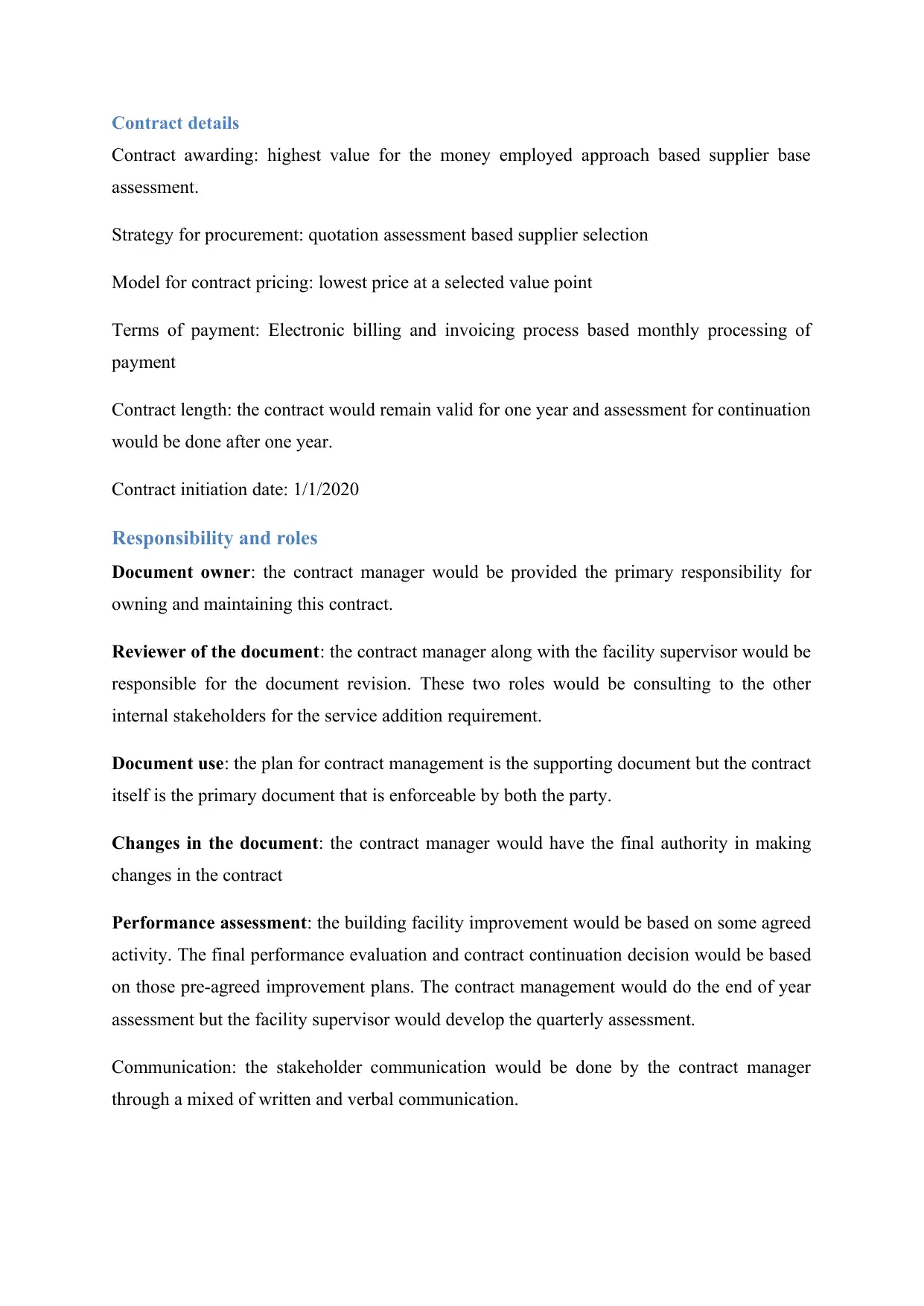
Contract details
Contract awarding: highest value for the money employed approach based supplier base
assessment.
Strategy for procurement: quotation assessment based supplier selection
Model for contract pricing: lowest price at a selected value point
Terms of payment: Electronic billing and invoicing process based monthly processing of
payment
Contract length: the contract would remain valid for one year and assessment for continuation
would be done after one year.
Contract initiation date: 1/1/2020
Responsibility and roles
Document owner: the contract manager would be provided the primary responsibility for
owning and maintaining this contract.
Reviewer of the document: the contract manager along with the facility supervisor would be
responsible for the document revision. These two roles would be consulting to the other
internal stakeholders for the service addition requirement.
Document use: the plan for contract management is the supporting document but the contract
itself is the primary document that is enforceable by both the party.
Changes in the document: the contract manager would have the final authority in making
changes in the contract
Performance assessment: the building facility improvement would be based on some agreed
activity. The final performance evaluation and contract continuation decision would be based
on those pre-agreed improvement plans. The contract management would do the end of year
assessment but the facility supervisor would develop the quarterly assessment.
Communication: the stakeholder communication would be done by the contract manager
through a mixed of written and verbal communication.
Contract awarding: highest value for the money employed approach based supplier base
assessment.
Strategy for procurement: quotation assessment based supplier selection
Model for contract pricing: lowest price at a selected value point
Terms of payment: Electronic billing and invoicing process based monthly processing of
payment
Contract length: the contract would remain valid for one year and assessment for continuation
would be done after one year.
Contract initiation date: 1/1/2020
Responsibility and roles
Document owner: the contract manager would be provided the primary responsibility for
owning and maintaining this contract.
Reviewer of the document: the contract manager along with the facility supervisor would be
responsible for the document revision. These two roles would be consulting to the other
internal stakeholders for the service addition requirement.
Document use: the plan for contract management is the supporting document but the contract
itself is the primary document that is enforceable by both the party.
Changes in the document: the contract manager would have the final authority in making
changes in the contract
Performance assessment: the building facility improvement would be based on some agreed
activity. The final performance evaluation and contract continuation decision would be based
on those pre-agreed improvement plans. The contract management would do the end of year
assessment but the facility supervisor would develop the quarterly assessment.
Communication: the stakeholder communication would be done by the contract manager
through a mixed of written and verbal communication.
⊘ This is a preview!⊘
Do you want full access?
Subscribe today to unlock all pages.

Trusted by 1+ million students worldwide
1 out of 18
Your All-in-One AI-Powered Toolkit for Academic Success.
+13062052269
info@desklib.com
Available 24*7 on WhatsApp / Email
![[object Object]](/_next/static/media/star-bottom.7253800d.svg)
Unlock your academic potential
Copyright © 2020–2025 A2Z Services. All Rights Reserved. Developed and managed by ZUCOL.